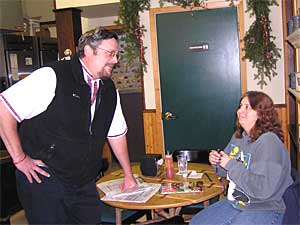|
Audio
Photos
Resources
Respond to this story
|
Rural Minnesota -- the new arts destination?
December 16, 2004
 |
| Patrick Moore, owner of the Java River Cafe in Montevideo, sells local artists' works on the walls. He says recently sales have gone way up. (MPR Photo/Annie Baxter) |
Montevideo, Minn. — For many years, the town of Montevideo has counted artists among the natural resources here. Folk artists can be found plying their craft in old farmhouses throughout these parts. Many of them teach at the Milan Village Arts School, just 15 miles away.
But Montevideo has only recently tried marketing itself as an arts destination. Lately, it seems to be paying off.
Local artists' works are for sale on the walls of a café downtown called Java River. Owner Patrick Moore says art sales at his shop have skyrocketed in the past year. And he's not just talking doubling or tripling.
 | |||
"I've gone, just this past year alone, from selling maybe $50 or $60 a month worth of art to averaging about $1,000 a month for art sales," he says.
Moore says sales are up due to collaborative efforts between Montevideo and neighboring cities to market the region's art together, and to lure art buyers in from out of town.
In October, they held a studio crawl called Meander. The event was part of a bigger marketing campaign directed at Twin Cities visitors, but people came from other parts as well -- at least 100 different cities and 13 different states.
With that kind of draw, some people in town wondered why they hadn't tried this kind of thing earlier.
"We really were missing the boat a little bit," says Dawn Hegland from the Upper Minnesota Valley Regional Development Commission.
Hegland says for a long time, artists in the Montevideo area had to go to bigger cities to sell their work.
 | |||
"We just don't have enough of a population base living there to sustain them," she says. "So of course they market their stuff elsewhere. And we thought well, let's take their market and bring it to us."
And that's the part that interests economists. When a city like Montevideo becomes an art destination, it has ripple effects throughout the community. That's the view of Ann Markusen, an economist at the University of Minnesota's Humphrey Institute.
Markusen studies how art communities affect economies. She says places like Grand Marais on the North Shore, with its arts colony, or Lanesboro in southeastern Minnesota, with its spacious visual arts center, have played a big role in stimulating area business.
"There are some remarkable cases where small towns -- including really tiny towns -- have been able to build an expertise or specialization in the arts that is supported by people spending their income on that, and revitalizing their downtowns," Markusen argues. "And {it} also really draws in people traveling, and encourages people to come and live there."
That last part is especially important. In order to sustain the energy of an "art town," artists need to be able to make a living.
 | |||
For artists in the Montevideo area, that's becoming easier to do. Local folk artist Lucy Tokheim runs a pottery studio with her husband on a remote country road -- not the most convenient location for visitors to come check out the Tokheims' Norwegian inspired pottery. But Lucy Tokheim says it seems to be working out.
"We put in many years going to art fairs. It's difficult. It's fun, but it's a difficult way to make a living. So we have developed this space, and people are visiting it. We're known as a destination point now, and that's a thrill," Tokheim says.
And it's a thrill even for people in the area who aren't big champions of art, according to café owner Patrick Moore.
"There aren't a lot of options left for small towns in a retail setting," he says. "And I think the traditional business community is interested in just about anything that would drive traffic and create interest."
Moore says he and other arts advocates in the area will keep working to prove that art can be just that kind of motor.
|
News Headlines
|
Related Subjects
|
